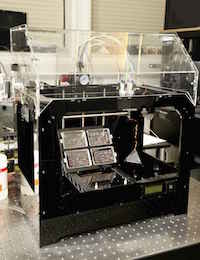Members Login

Channels
Special Offers & Promotions
Miniature VHS Solenoid Play Significant Role in the Viability of 3D Bio-Printing of Human Cells
The rapid development of viable inkjet technology for highly specialised applications, such as printing human cells, continues to generate significant interest.
 If successful, the realisation of this technology for specialised biological applications, generally known as ‘biofabrication’, has the potential to replace the long established (and often controversial) process of using animals for testing new drugs. However, there are many challenges to overcome to enable the successful production of a valve-based cell printer for the formation of human embryonic stem cell spheroid aggregates. For example, printing techniques need to be developed which are both controllable and less harmful to the process of preserving human cell tissue viability and functions.
If successful, the realisation of this technology for specialised biological applications, generally known as ‘biofabrication’, has the potential to replace the long established (and often controversial) process of using animals for testing new drugs. However, there are many challenges to overcome to enable the successful production of a valve-based cell printer for the formation of human embryonic stem cell spheroid aggregates. For example, printing techniques need to be developed which are both controllable and less harmful to the process of preserving human cell tissue viability and functions.
One particular cell printing project at an advanced stage and which has benefitted from the features and benefits of LEE PRODUCTS miniature VHS solenoid valves and nozzles, is the result of pioneering activities at Edinburgh’s Heriot-Watt University. Dr Will Shu at the University’s Biomedical micro-engineering Group and his colleagues, including Alan Faulkner-Jones a bioengineering PhD student have successfully developed a bio-printer which has been demonstrated at the 3D Print show in London. Also involved in the development of the bio-printer are specialists at Roslin Cellab in Midlothian, a leading stem cell technology company.
The valve based bio-printer has been validated to print highly viable cells in programmable patterns from two different bio-inks with independent control of the volume of each droplet (with a lower limit of 2nL or fewer than five cells per droplet). Human ESC’s (Embryonic Stem Cells) were used to make spheroids by overprinting two opposing gradients of bio-ink; one of hESC’s in medium and the other of medium alone.
The resulting array of uniform sized droplets with a gradient of cell concentrations was inverted to allow cells to aggregate and form spheroids via gravity.
The resulting aggregates have controllable and repeatable sizes and consequently they can be made to order for specific applications. Spheroids with between 5 and 140 dissociated cells resulted in spheroids of 0.25-0.6 mm diameter. The success of the bio-printer demonstrates that a valve based printing process is gentle enough to maintain stem cell viability, accurate enough to produce spheroids of uniform size and that printed cells maintain their pluripotency.
Looking closer at the design of the bio-printer platform reveals two dispensing systems, each comprising a Lee VHS Nanolitre solenoid dispensing valve with a Teflon coated 101.6 µm internal diameter Lee Minstac nozzle controlled by a Arduino microcontroller. Each dispensing system is attached to a static pressure reservoir for the bio-ink solution to be dispensed via flexible tubing. The dispensing system and bio-ink reservoirs are mounted within a custom-built enclosure on the tool head of a micrometer-resolution 3-axis 3d printing platform (High-Z S-400, CNC Step) and controlled by a customized CNC controller (based on G540, Geokodrives).
A relatively larger nozzle diameter (compared to the size of the cells that are printed) was selected to reduce the amount of shear stress that could be experienced by the cells during the dispensing process. The bio-ink reservoirs were kept as close as possible to the valves in order to minimise the amount of time it would take to charge the system with bio-ink and to purge it at the end of the experiment. A USB microscope is also included to enable visual inspection of the target substrate during the printing process. Due to the type of deposition system used, a direct line of sight view through the nozzle is not possible and therefore the USB microscope is mounted at an offset angle from the cell deposition system assemblies.
Commenting on the development of the bio-printer and the vital role played by Lee Product’s VHS solenoid valves, Dr Will Shu at Heriot-Watt University said, “Printing living cells is extremely challenging and to the best of our knowledge, this is the first time that these cells have been 3D printed.
The technique will allow us to create more accurate human tissue models which are essential to in-vitro drug development and toxicity testing and since the majority of drug discovery is targeting human disease, it makes sense to use human tissues. Dr Shu continued ”The development of the bio-printer has taken many years of effort and we are very pleased with the performance of Lee’s VHS solenoid valves, they are a vital component within the bio-printer printhead and we recommend them to our colleagues working on similar projects” Dr Shu added, “We also acknowledge the support and interaction from our contacts at Lee Products which has helped us to overcome the challenges of this project”.
This highly specialised application is an excellent example of the performance of Lee’s range of VHS Micro-Dispense Solenoid Valves which provide precise, repeatable, non-contact dispensing of fluids in the nanolitre to microlitre range. The valves feature a number of port configurations to facilitate quick and convenient connections to Lee’s 062 MINSTAC fittings and press-on tubing. The 062 MINSTAC outlet port can be used with Lee 062 MINSTAC tubing or atomising nozzles. Custom configurations and voltages are also available to suit specific applications.
Media Partners


